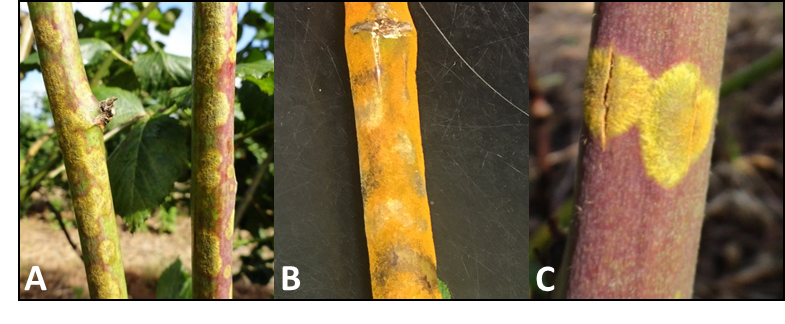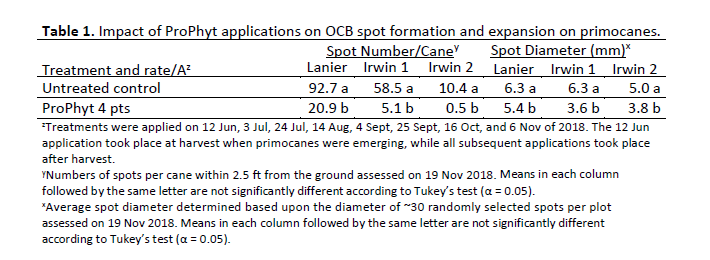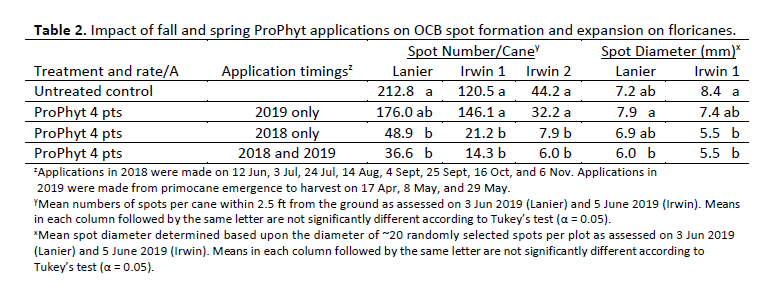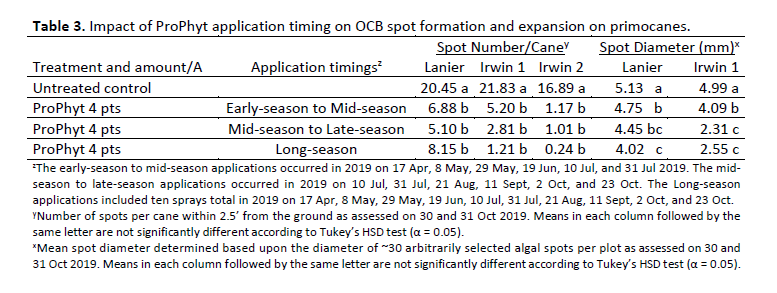By Jonathan E. Oliver, Will H. Hemphill, and Phillip M. Brannen, Department of Plant Pathology, University of Georgia
Introduction
Among the diseases affecting blackberry production in the southeastern U.S., one of the more unusual disease issues is orange cane blotch (OCB). OCB disease of blackberry was first reported in Arkansas in 1997 (Holcomb et al. 1998), and it has since become a prevalent issue in many blackberry production sites throughout the Coastal Plain region of the southeastern U.S. Though, in most cases, this disease does not limit blackberry production, recent research has elucidated the impacts of this disease on blackberry yield, the details of the disease cycle, and the options for effective chemical management (Browne et al. 2019a,b; Browne et al. 2020; Hemphill 2019).

Orange Cane Blotch Causal Agent, Symptoms, and Yield Impacts
While most plant diseases are caused by fungal, bacterial, viral, or oomycete pathogens, OCB disease of blackberry is caused by a parasitic algal species, Cephaleuros virescens (Brannen 2018). In fact, the orange blotches of OCB are actually pigmented algal filaments and reproductive structures (Holcomb et al. 1998). As the name of this disease indicates, the most readily observable symptom of OCB is the presence of orange-to-yellow blotches (or spots) on the canes of infected blackberry plants (Figure 1A).
Typically, the orange disk-shaped blotches are more prevalent near the base of the affected cane, and these blotches may coalesce to cover virtually the entire cane surface under conditions favorable for disease development (wet, humid conditions). Another name for this disease, orange felt, reflects the fact that these blotches sometimes take on the appearance of an orange felt-like material on the surface of the cane (Figure 1B). Superficially, insomuch as they are orange, these spots may resemble pustules caused by rust fungi; however, these felt-like blotches do not readily “rub off” or stain surfaces like the spores produced within a rust pustule (Brannen 2018). As orange blotches develop, they can often result in cracking of the cane surface (Figure 1C). The cracking and wounding caused by OCB is believed to allow for the entry of additional disease-causing organisms. In particular, cane blight and Botryosphaeria-related diseases have been more frequently observed to cause problems in blackberry plantings where severe problems with OCB have been noted.
Furthermore, while yield impacts resulting from OCB disease were initially not clear, recent research at the University of Georgia has now shown that OCB can significantly reduce blackberry yield. In particular, canes with larger and more numerous orange blotches were shown to produce significantly fewer berries than canes with little/no OCB blotches (Browne et al. 2020). Berry size and cane growth, by contrast, do not appear to be significantly impacted by OCB.
Orange Cane Blotch Disease Cycle
Orange blotches produced by this disease are usually first observed on primocanes in the late summer and fall. Therefore, it was formerly assumed that infection of primocanes took place throughout the summer and fall, with subsequent infections of these canes (now floricanes) taking place in the spring. However, recent field observational research at the University of Georgia strongly suggests that this disease is monocyclic (has only one infection cycle per year), with this alga only infecting new primocanes during one period in the late spring and early summer (Hemphill 2019). Microscopy, combined with biweekly photography of blackberry canes, indicates that algal reproductive structures (sporangiophores containing zoospores) are produced on floricanes only in late-May to mid-July in southern Georgia. Furthermore, all blotches present on primocanes by the end of the season can be traced back to tiny red spots which appear during June and July, suggesting that virtually all new infections are occurring prior to fall (and are apparently a result of the observed algal reproduction in late-May to mid-July) (Figure 2).

Based on this observational work, it is believed that the timings of key events in the disease cycle of OCB in southern Georgia are as follows:
- On infected floricanes, algal sporangiophores [the orange felt-like material on the cane surface] are formed (late-May to mid-July)
- On infected floricanes, sporangiophores release zoospores from sporangia and infect newly emerged primocanes (late-May to mid-July)
- On newly infected primocanes, algal blotches begin to form and become visible as they enlarge in size (June and July).
- On infected primocanes, algal blotches continue to enlarge and become recognizable as orange cane blotch lesions (August and September).
- Infected primocanes enter dormancy, during which time algal blotches stop expanding in size (December).
- Primocanes infected during the previous season (now called floricanes) emerge from dormancy, and algal blotch expansion resumes until sporangiophores are formed in May (April and May [of the next season]).
Management
Cultural Controls for Orange Cane Blotch
Unfortunately, cultural control measures alone are typically not sufficient to control OCB on blackberry in the southeastern U. S. Nonetheless, for optimal OCB management, the following practices are recommended (Brannen 2018):
- Remove old floricanes immediately after harvest. Since the algal sporulation period overlaps with and extends past harvest (approximately June in southern Georgia), the prompt removal of sporulating floricanes following harvest may reduce the chances of new primocane infections.
- Implement practices that promote quick drying of the canopy. These include thinning plants, establishing a weed-free strip, bedding with black plastic, and using drip-tape (rather than overhead) irrigation. In addition, at establishment, the avoidance of poorly drained sites is strongly encouraged. It is assumed that moisture plays a significant role in the algal life cycle, and anecdotal evidence suggests that reducing moisture in the canopy can reduce OCB infection.
- Maintain adequate water and nutrient conditions to avoid stressing plants. In other commodities where algal diseases occur, stressed plants are more readily infected with C. virescens than unstressed plants.
Chemical Control of Orange Cane Blotch
While copper products are effective for controlling other algal diseases, these products have not been found to be effective versus OCB in Georgia blackberry production. By contrast, phosphonate fungicides (including potassium phosphite) have been shown to reduce the severity of OCB in blackberries (Browne et al. 2019b). Previous trial work, however, did not specify whether potassium phosphite reduces OCB severity by reducing the number of spots (initial infections) or by reducing the size of spots (expansion after infection) on canes of infected blackberry. Furthermore, since OCB spots do not become apparent on new primocanes until the fall, growers have tended to begin chemical applications in the fall, after OCB spots become obvious; however, the optimal timing of potassium phosphite applications has not been examined previously in a comprehensive manner.
To assess both the impact of potassium phosphite on OCB development and the effect that application timing has on OCB control, a series of three field trials were carried out in 2018 and 2019 in commercial blackberry plantings in southern Georgia. Each of the three trials was replicated in each of three plantings in Lanier and Irwin counties in Georgia. Two plantings were located in Irwin County (blackberry cultivar ‘Ouachita’) and one planting was located in Lanier County (blackberry cultivar ‘Osage’). Treatments consisted of untreated control plants or plants treated with potassium phosphite (ProPhyt; Luxembourg Chemical) applied at 4 pts/A. Treatments were applied until runoff (equivalent to 50 gal water/A) using a backpack sprayer with a yellow poly flat fan tip (0.15 gpm, 30 degree angle). The rows adjacent to the test plots served as buffer rows, and phosphonate fungicides were not applied to these rows for the duration of the experiment. Within an area of interest consisting of the bottom 2.5 ft from the crown, disease severity in the treated versus untreated plants was assessed in terms of relative algal spot size (spot diameter in mm) and number of algal spots per cane. All cultural practices at each location throughout the trial were consistent with blackberry production methods commonly observed in the Southeast.
Trial 1: Potassium phosphite limits the infection of new primocanes as well as the expansion of algal spots after infection.
In the first trial, spots were assessed on primocanes in the fall of 2018 (Hemphill et al. 2019). Treatments were applied to a randomized complete block design. In this trial, ProPhyt applications reduced both algal spot number and algal spot diameter on primocanes relative to the untreated control treatment, suggesting that ProPhyt may act to limit both the infection of new primocanes as well as the expansion of algal spots after infection.

Trial 2: Spring applications of potassium phosphite do not significantly impact blotch number or blotch size on floricanes infected during the previous season.
In the second trial, spots were assessed on floricanes in the spring of 2019 (Hemphill et al. 2020a). Treatments were assigned using a split plot design, with 2018 treatments (sprayed or not sprayed) representing the main plot and 2019 treatments (sprayed or not sprayed) representing the sub plots. Treatments consisted of: (1) ProPhyt applications in 2018 and 2019, (2) ProPhyt applications in 2018 only, (3) ProPhyt applications in 2019 only, and (4) an untreated control. In this trial, both of the treatments that included ProPhyt applications in 2018 resulted in a numerical reduction in algal spot number and algal spot diameter relative to the untreated control; however, additional applications of ProPhyt in 2019 did not have a significant impact on OCB in terms of either spot number or diameter on floricanes.

Trial 3: Both early-season to mid-season and mid-season to late-season applications of potassium phosphite can limit the infection of new primocanes, while mid-season to late-season applications can more effectively limit the expansion of algal spots after infection.
In the third trial, spots were assessed on primocanes in the fall of 2019 (Hemphill et al. 2020b). Treatments were applied to a randomized complete block design. Treatments consisted of early-season to mid-season ProPhyt applications, mid-season to late-season ProPhyt applications, long-season ProPhyt applications, and an untreated control. The beginning of early-season to mid-season applications coincided with primocane emergence, and the beginning of the mid-season to late-season applications coincided with algal sporulation on floricanes. In this trial, all ProPhyt treatments resulted in a significant reduction in spot number and diameter relative to the untreated control; however, the mid-season to late-season and long-season applications resulted in significantly smaller spots versus the early-season to mid-season applications of ProPhyt.

Conclusions Regarding OCB Chemical Control
Based upon the results of these trials, it is currently recommended that growers begin applications of potassium phosphite in the late spring, following the emergence of primocanes and immediately prior to the algal sporulation period. In southern Georgia, this would correspond to beginning applications in approximately early- to mid-May. In sites with a history of issues with OCB, it is suggested that applications should be made approximately 3-4 weeks apart for a total of six applications.
For additional disease control recommendations for conventional blackberry production, please see the Southeast Regional Caneberries Integrated Management Guide (at www.smallfruits.org). Fungicide availability, labels, and recommended rates change frequently and vary between states and localities. Please consult the various labels for rates, other recommendations, and precautions.
References
Brannen, P. 2018. Orange felt (orange cane blotch) of blackberry. University of Georgia Cooperative Extension Circular 892.
Browne, F. B., Brannen, P. M., Scherm, H., Richardson, E. A., and Taylor, J.R. 2020. Yield Response to Orange Cane Blotch of Blackberry Grown in the Georgia Coastal Plain. Plant Dis. 104(1):161–167.
Browne, F. B., Brannen, P. M., Scherm, H., Brewer, M. T., Wilde, S. B., and Richardson, E. A. 2019a. Orange cane blotch of commercial blackberry in the southeastern United States. Plant Health Prog. 20:67-69.
Browne, F. B., Brannen, P. M., Scherm, H., Taylor, J. R., Shealey, J. S., Fall, L. A., and Beasley, E. D. 2019b. Evaluation of disinfectants, algicides, and fungicides for control of orange cane blotch of blackberry in the field. Crop Protect. 122:112-117.
Hemphill, W., Oliver, J.E., Brannen, P. 2020a. Evaluation of late-season and early-season applications of potassium phosphite for management of orange cane blotch on blackberry floricanes in Georgia, 2019. PDMR. 14:PF069.
Hemphill, W., Oliver, J.E., & Brannen, P. 2020b. Evaluation of early-season, late-season, and long-season applications of potassium phosphite for management of orange cane blotch on blackberry primocanes in Georgia, 2019. PDMR. 14:PF031.
Hemphill, W., Brannen, P., & Oliver, J.E. 2019. Efficacy of potassium phosphite for control of orange cane blotch of blackberry in Georgia, 2018. PDMR. 13:PF010.
Hemphill, W.H. 2019. M.S. Thesis. Cane diseases of blackberry: identification of causal agents and modifications of management recommendations for cane blight and orange cane blotch. Department of Plant Pathology, University of Georgia, Tifton, GA.
Holcomb, G. E., Vann, S. R., and Buckley, J. B. 1998. First report of Cephaleuros virescens in Arkansas and its occurrence on cultivated blackberry in Arkansas and Louisiana. Plant Dis. 82:263-263.